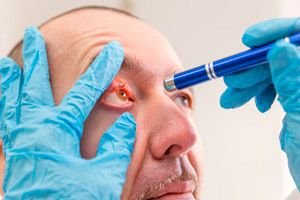
All iLive content is medically reviewed or fact checked to ensure as much factual accuracy as possible.
We have strict sourcing guidelines and only link to reputable media sites, academic research institutions and, whenever possible, medically peer reviewed studies. Note that the numbers in parentheses ([1], [2], etc.) are clickable links to these studies.
If you feel that any of our content is inaccurate, out-of-date, or otherwise questionable, please select it and press Ctrl + Enter.
Corneal sensitivity study
Medical expert of the article
Last reviewed: 07.07.2025

The cornea is a highly sensitive membrane of the eyeball. In various pathological conditions of the eye, its sensitivity can significantly decrease or completely disappear, so its determination can be a very informative indicator when establishing a diagnosis.
The study is performed in various ways. Some methods provide approximate data, while others are more precise. To roughly determine the level of tactile sensitivity of the cornea, a moistened cotton wick is used, which is touched to the cornea first in the central section, and then at four points on the periphery with the patient's eyes wide open. The absence of a reaction to the touch of the wick indicates gross sensitivity disorders. More subtle studies of corneal sensitivity are performed using special graduated hairs (Frey-Samoylov method), algesimeters and keratoesthesiometers.
In our country, the hair method of determining the tactile sensitivity of the cornea has been used for a long time. It consists of successively touching 13 points of the cornea with three (with a force of 0.3; 1 and 10 g per 1 mm 3 ) or four (a hair with a force of 3 g per 1 mm3 is added ) hairs. Normally, a hair with a pressure of 0.3 g / mm 3 is felt in 7-8 points, 1 g / mm 3 - in 11-12 points, and a hair exerting a pressure of 10 g / mm 3 causes not only tactile but also painful sensations. This method is simple and accessible, but is not without drawbacks: standardization and sterilization of hairs, as well as determination of the threshold perception value are impossible. The algesimeters created by B. L. Radzikhovsky and A. N. Dobromyslov are free from most of the above-mentioned shortcomings, but they also cannot be used to determine the threshold sensitivity of the cornea, and the patient’s lying position is not always convenient for the study.
In technical terms, the most advanced at present are optical-electronic esthesiometers.
 [ 1 ], [ 2 ], [ 3 ], [ 4 ], [ 5 ], [ 6 ], [ 7 ], [ 8 ], [ 9 ]
[ 1 ], [ 2 ], [ 3 ], [ 4 ], [ 5 ], [ 6 ], [ 7 ], [ 8 ], [ 9 ]

